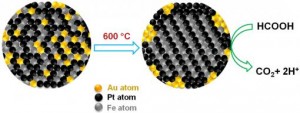An Oct. 25, 2013 Simon Fraser University (SFU; Vancouver, Canada) news release touts a new centre and a very snazzy piece of equipment (Nano X-ray Computed Tomography [NXCT]) that scientists will be able to build and purchase courtesy of a new grant (Note: Links have been removed),
Powerful scanners that give scientists a direct line of sight into hydrogen fuel cells are the latest tools Simon Fraser University researchers will use to help Ballard Power Systems Inc create more durable, lower-cost fuel cells. Use of these fuel cells in vehicles can substantially reduce harmful emissions in the transportation sector.
The new Nano X-ray Computed Tomography (NXCT) tools will become part of a nationally unique fuel cell testing and characterization facility. The new four-year, $6.5 million project is receiving $3.39 million in funding from Automotive Partnership Canada (APC).
It’s one of 10 university-industry partnerships receiving a total of more than $52 million ($30 million from APC, leveraged by more than $22 million from industry and other partners) announced today by the Natural Sciences and Engineering Research Council of Canada (NSERC).
Research carried out in the new visualization facility, expected to be operational by spring, will further the ongoing research collaboration between Ballard and SFU.
“This will be an unprecedented, world-class testing facility dedicated entirely to this project over the next four years,” says principal investigator Erik Kjeang, an internationally known fuel cell expert and director of SFU’s Fuel Cell Research Laboratory (FCRel). “Beyond its capabilities, that’s a strength in itself.”
Says Ballard’s Research Manager Shanna Knights: “It’s a unique opportunity, to have dedicated access to highly specialized equipment and access to university experts who are focused on Ballard’s needs.”
Researchers will use the facility to develop and advance the technology required for the company’s next generation of fuel cell products, helping to meet its targets related to extending fuel cell life while improving efficiency.
Kjeang, an assistant professor in SFU’s School of Mechatronic Systems Engineering, says the new, sophisticated nano-scale scanning capabilities will enable researchers to see inside the fuel cell micro-structure and track how its components degrade over time. The research will play an important role in the university’s focus on advancing clean energy initiatives.
“Partnerships with leading companies such as Ballard solidify SFU’s reputation as a world-class innovator in fuel cell research,” says Nimal Rajapakse, dean and professor, Faculty of Applied Sciences. “This unique fuel cell testing facility will be used for cutting edge research and training of HQP (highly qualified personnel) that will help to strengthen the competitiveness of the Canadian automotive and clean energy industry. We are grateful that Automotive Partnership Canada has provided this second round of funding to support the SFU-Ballard research collaboration.”
Adds Kjeang: “Thanks to the APC program, and the support NSERC has provided over the years, I have been able to both explore the fundamentals of fuel cell technology and to successfully work with companies who are making globally leading advances in green automotive technology.”
A former research engineer who began his career at Ballard in 2008, Kjeang came to SFU to continue his own research interests while keeping a foot in industry. He also continues to lead a complementary project with Ballard that involves nearly 40 students and researchers working to improve the durability of heavy-duty bus fuel cells.
You can find the news release with all its links intact here. I am a little surprised that there isn’t any mention of SFU’s 4D Labs (their nanotechnology showcase project), especially since one of the areas of interest is this (from the 4D Labs Research Areas webpage),
Cleaner Energy
New materials innvovation is critical to lower the costs and improve the performance of promising technologies such as photovoltaics, fuel cells and passive energy control sytems. [emphasis mine]
Meanwhile, experts gathered at the University of Toronto debated nanotechnology by asking this question: revolution or evolution? as part of a celebratory event extending from Oct. 23 to Oct. 24, 2013. From a University of Toronto Oct. 23, 2013 news release (H/T Hispanic Business.com),
A panel of nanotechnology experts, moderated by U of T Materials Science & Engineering Professor Doug Perovic will explore the possibilities of the technology as part of a celebration marking the University of Toronto’s Department of Materials Science & Engineering’s 100-year anniversary.
Nanotechnology is the science of manipulating atoms and molecules on a scale so small they can’t be seen with an ordinary microscope. It’s about coaxing them into displaying unusual properties, such as a material 10 times as strong as steel, but a fraction of its weight, or solar panels that produce fuel rather than electricity.
While nanotech has the potential to transform society in ways no one ever thought of before, it’s also been the subject of much hype.
“Some would say it has not met expectations,” says Professor Perovic, Canada’s ‘nabob of nanotechnology.’ “While it hasn’t taken off in the areas people predicted it would take off, it has become huge in unpredictable areas.”
Some of the world’s top nanotechnology experts will be part of the panel and give the big picture.
WHAT: Nanotechnology panel featuring several experts
WHERE: Room#: BA 1130, Bahen Centre for Information Technology, University of Toronto, 40 St. George Street (Google map: http://goo.gl/maps/tXBxP)
WHEN: 10am, Thursday (October 24)
WHO:
Michael F. Ashby
Royal Society Research Professor
Department of Engineering
University of CambridgeShawn Qu | MMS PhD 9T5
Chairman, President & CEO
Canadian Solar Inc.Polina Snugovsky
Chief Metallurgist, Celestica Inc.
Robert B. Storey | MMS 7T7
Managing Partner, Bereskin & Parr LLPGino Palumbo
MMS 8T3, MASc 8T5, PhD 8T9
President & CEO, Integran Technologies IncDonald R. Sadoway
EngSci 7T2, MMS MASc 7T3, PhD 7T7
John F. Elliot Professor of Materials Chemistry
Department of Materials Science & Engineering, MITDavid S. Wilkinson
EngSci 7T2, MMS MASc 7T4
Vice-President & Provost, Academic
McMaster University
I wonder if the experts came to any conclusions.
